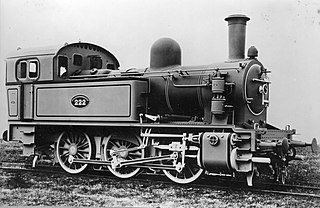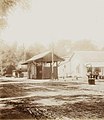
0-6-0 is the Whyte notation designation for steam locomotives with a wheel arrangement of no leading wheels, six powered and coupled driving wheels on three axles, and no trailing wheels. Historically, this was the most common wheel arrangement used on both tender and tank locomotives in versions with both inside and outside cylinders.

The majority of Indonesia's railways are on Java, used for both passenger and freight transport. There are three noncontinuous railway networks in Sumatra while two new networks are being developed in Kalimantan and Sulawesi. Indonesia has finalized its plan for a national railway network recently. According to the plan, 3,200 km of train tracks that will criss-cross the islands of Sumatra, Java, Kalimantan, and Sulawesi, it has been touted as the most extensive railway project in Indonesia since its independence from the Dutch in 1945. Indonesia targets to extend the national railway network to 10,524 kilometres by 2030. As of September 2022, the network spans 7,032 km.

Pasuruan is a city in East Java, Java, Indonesia. It had a population of 186,262 at the 2010 Census and 208,006 at the 2020 Census; the official estimate as at mid 2022 was 211,497.

Surabaya Pasar Turi Station or Surabaya Pasarturi Station (SBI) is the second largest railway station in Surabaya, East Java. It is located near the Pasar Turi market in Bubutan, Surabaya. It is the main departure point of all train from Surabaya which passes through Pantura to the western cities of Java such as Jakarta and Semarang, but trains south and east line from Surabaya departed from Surabaya Gubeng. Since 2014, the station has upgraded railway signal and railroad switch devices from mechanical to electrical type produced by Len Industri.

Cirebon Station also known as Cirebon Kejaksan Station is the main railway station in the Cirebon area located on Siliwangi Street, Kebonbaru, Kejaksan, Cirebon. The station is located at DAOP 3 area as North Cross Line, but in this station there is also cross line in Purwokerto Station which is connected by South Cross Line in Kroya Station. Therefore, most of the trains both north and south lines stopped at this station, except economy class train which is stop at Cirebon Prujakan.

Wonokromo Station (WO) is a large class type C railway station in Jagir, Wonokromo, Surabaya, East Java, operated by Kereta Api Indonesia. The station is located about 5 kilometers (3 mi) south of Surabaya Gubeng Station. It is close to the railway junction with each directions to Surabaya Gubeng station, Sidoarjo, and Madiun.
Most railway lines in Indonesia were constructed during the Dutch colonial rule. After independence in 1945, many lines were abandoned. The current national rail operator, PT Kereta Api Indonesia (Persero), was founded on 28 September 1945.

The Naamlooze Vennootschap.Nederlandsch-Indische Spoorweg Maatschappij, abbreviated to NIS, NISM or N.V. NISM was a private-owned railways company in charge of rail transport in Java, Dutch East Indies. The company's headquarters were in Semarang, Central Java. The company started its maiden route from Semarang to Vorstenlanden and in 1873 they also built their line to the Willem I Railway Station of Ambarawa–Kedungjati and Batavia–Buitenzorg lines. Later the network expanded to Bandung and Surabaya. It was absorbed into the present Kereta Api Indonesia after Indonesian independence in 1945. It was the main competitor to Staatsspoorwegen as state-owned railway company and established on April 6, 1875.

The Serajoedal Stoomtram Maatschappij was a railway company, whose route followed the Serayu Valley and connected Maos via Patikraja, Purwokerto, Sokaraja, Purbalingga, Klampok, Mandiraja and Banjarnegara with Wonosobo on 142 kilometers of rail network. This company are the pioneer of railway development in Banyumas Regent, even before Staatsspoorwegen exist in earlier 1900's.

The Madoera Stoomtram Maatschappij on Madura Island today's Indonesian province of Jawa Timur was one of the railway companies in the Dutch East Indies. The company had its headquarters in The Hague and was licensed in 1896. In 1901 it put the first steam trams in operation to connect the western with the eastern end of the island.

The Samarang–Joana Stoomtram Maatschappij, N.V. was from 1879 to 1959 a private tram company on the Dutch East Indies, providing passenger and freight trains on a 417 kilometres (259 mi) long network with a gauge of 3 feet 6 inches (1,067 mm).

Staatsspoorwegen was a state-owned railway company managed by the Dutch East Indies colonial government. It was absorbed into the present Kereta Api Indonesia after Indonesian independence in 1945. The main competitor was Nederlandsch-Indische Spoorweg Maatschappij (NIS) as private-owned railways company which had standard gauge and cape gauge lines.

The NS 8500 was a series of tank engines with the C (0-6-0) wheel layout of the Dutch Railways (NS) and its predecessor Maatschappij tot Exploitatie van Staatsspoorwegen (SS). They were manufactured by Hohenzollern and Henschel & Sohn.

The NS 7100 was a series of tank engines of the Dutch Railways (NS) and its predecessors Maatschappij tot Exploitatie van Staatsspoorwegen (SS), Hollandsche IJzeren Spoorweg-Maatschappij (HSM) and Noord-Friesche Locaalspoorweg-Maatschappij (NFLS).

The NS 7700 was a series of tank engines of the Dutch Railways (NS) and its predecessor the Hollandsche IJzeren Spoorweg-Maatschappij (HSM).

There was a tram system in Surabaya, East Java, Indonesia from 1889 to 1978. The tramway was operated by a private company Oost-Java Stoomtram Maatschappij, and later by Kereta Api Indonesia (KAI), and was the only OJS-owned rail system survived in post-independence Indonesia. The tramway linked Ujung with Wonokromo and continued towards Krian in Sidoarjo. All land assets of the tramway is currently owned by Operational Area VII Surabaya of the KAI.

Pasuruan Station (PS) is a II class railway station located in Trajeng, Panggungrejo, Pasuruan; this station entered within western border of PT.KAI Operation Area IX of Jember at the height of 3 meters above sea level.

Bangil Station (BG) is a class I (one) railway station located in Pogar, Bangil, Pasuruan Regency; entered within eastern border of Operational Area VII Surabaya of Kereta Api Indonesia (KAI) at the height of ± 9 meters above sea level. To the east of this station, there are branches towards Pasuruan-Probolinggo-Jember-Banyuwangi and to Malang.

Oost-Java Stoomtram Maatschappij (OJS) is the name of a private railway company which once operated in Surabaya, Dutch East Indies. The network have 46 stops with a total of near 66 miles track; prior to its demise, it operates between the cities of Surabaya, Sidoarjo, Mojokerto Regency and Jombang Regency, on a mixture of former railway lines and urban on-street running.


































